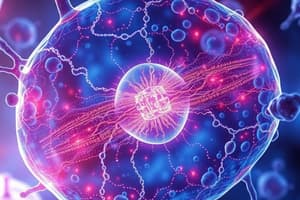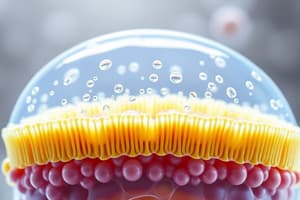Podcast
Questions and Answers
What occurs during transcytosis?
What occurs during transcytosis?
- Vesicles fuse with intracellular compartments.
- Materials move between blood plasma and interstitial fluid. (correct)
- Vesicles transport solutes across the cytoplasm.
- Vesicular contents are released into intracellular fluid.
In osmosis, water moves from an area of _____ water concentration to an area of _____ water concentration.
In osmosis, water moves from an area of _____ water concentration to an area of _____ water concentration.
- equal; varying
- varied; constant
- lower; higher
- higher; lower (correct)
What are aquaporins primarily used for in osmosis?
What are aquaporins primarily used for in osmosis?
- Transporting solutes across the membrane.
- Facilitating the movement of ions.
- Functioning as water channels in membranes. (correct)
- Blocking osmotic pressure.
What is the role of osmotic pressure?
What is the role of osmotic pressure?
Which statement best describes isosmotic solutions?
Which statement best describes isosmotic solutions?
What is a key condition for osmosis to occur?
What is a key condition for osmosis to occur?
What determines the rate of carrier-mediated facilitated diffusion?
What determines the rate of carrier-mediated facilitated diffusion?
What is the Transport Maximum in carrier-mediated facilitated diffusion?
What is the Transport Maximum in carrier-mediated facilitated diffusion?
Which substances are typically transported via carrier-mediated facilitated diffusion?
Which substances are typically transported via carrier-mediated facilitated diffusion?
What type of transport requires energy to move substances against a concentration gradient?
What type of transport requires energy to move substances against a concentration gradient?
Which process is known as primary active transport?
Which process is known as primary active transport?
How does the Sodium-Potassium pump function?
How does the Sodium-Potassium pump function?
Which of the following statements is an example of secondary active transport?
Which of the following statements is an example of secondary active transport?
Which of the following processes exhibits saturation?
Which of the following processes exhibits saturation?
What happens when all carriers for a specific substance are occupied?
What happens when all carriers for a specific substance are occupied?
What is the primary function of the plasma membrane?
What is the primary function of the plasma membrane?
Which component of the nucleus is responsible for synthesizing ribosomal RNA?
Which component of the nucleus is responsible for synthesizing ribosomal RNA?
What is the primary function of the Golgi apparatus?
What is the primary function of the Golgi apparatus?
Which organelle is primarily involved in ATP synthesis?
Which organelle is primarily involved in ATP synthesis?
What describes the fluid mosaic model of the plasma membrane?
What describes the fluid mosaic model of the plasma membrane?
What is the function of ribosomes within the cell?
What is the function of ribosomes within the cell?
What is the function of the smooth endoplasmic reticulum?
What is the function of the smooth endoplasmic reticulum?
What is the role of centrioles during cell division?
What is the role of centrioles during cell division?
What is the primary function of cilia?
What is the primary function of cilia?
What process involves the random mixing of particles in a solution due to their kinetic energy?
What process involves the random mixing of particles in a solution due to their kinetic energy?
Which factor does NOT affect the rate of diffusion?
Which factor does NOT affect the rate of diffusion?
In simple diffusion, which type of molecules can pass freely through the lipid bilayer?
In simple diffusion, which type of molecules can pass freely through the lipid bilayer?
Which of the following assists substances across the membrane during facilitated diffusion?
Which of the following assists substances across the membrane during facilitated diffusion?
What occurs when a concentration gradient is particularly steep?
What occurs when a concentration gradient is particularly steep?
Which of the following molecules is an example of a substance that moves through simple diffusion?
Which of the following molecules is an example of a substance that moves through simple diffusion?
What does an increase in temperature do to the rate of diffusion?
What does an increase in temperature do to the rate of diffusion?
What is one consequence of increased diffusion distance?
What is one consequence of increased diffusion distance?
Which of the following is NOT a characteristic of facilitated diffusion?
Which of the following is NOT a characteristic of facilitated diffusion?
Which type of molecules typically passes through the lipid bilayer without assistance?
Which type of molecules typically passes through the lipid bilayer without assistance?
What is the primary function of sodium and potassium concentrations in cells?
What is the primary function of sodium and potassium concentrations in cells?
What mechanism uses the energy stored in an ionic concentration gradient?
What mechanism uses the energy stored in an ionic concentration gradient?
What type of transporter moves two substances in the same direction across the membrane?
What type of transporter moves two substances in the same direction across the membrane?
Which type of endocytosis is highly selective and takes up specific ligands?
Which type of endocytosis is highly selective and takes up specific ligands?
What is the initial step in the process of receptor-mediated endocytosis?
What is the initial step in the process of receptor-mediated endocytosis?
What type of cells are macrophages?
What type of cells are macrophages?
What happens to the plasma membrane during phagocytosis?
What happens to the plasma membrane during phagocytosis?
What forms as a result of the membrane fusion during phagocytosis?
What forms as a result of the membrane fusion during phagocytosis?
Which process involves the degradation of substances in lysosomes?
Which process involves the degradation of substances in lysosomes?
What is the role of carrier proteins in secondary active transport?
What is the role of carrier proteins in secondary active transport?
Study Notes
Cell Structure and Functions
- Plasma Membrane: Composed of a lipid bilayer with phospholipids, cholesterol, and embedded proteins; regulates substance entry and exit and facilitates cell communication.
- Nucleus: Control center with nuclear envelope; contains DNA and nucleoli; regulates protein synthesis and cell functions.
- Ribosome: Made of ribosomal RNA and proteins; site of protein synthesis; exists as free ribosomes in cytoplasm or attached to rough ER.
- Rough Endoplasmic Reticulum (ER): Studded with ribosomes; synthesizes and transports proteins to the Golgi apparatus.
- Smooth Endoplasmic Reticulum (ER): Lacks ribosomes; involved in lipid and carbohydrate synthesis, detoxification, and calcium storage.
- Golgi Apparatus: Stacked membrane sacs that modify, package, and distribute proteins and lipids for secretion or internal use.
- Lysosome: Contains digestive enzymes; involved in breaking down waste materials.
- Peroxisome: Sites of lipid and amino acid degradation; breaks down hydrogen peroxide.
- Proteasomes: Protein complexes that degrade unneeded or damaged proteins in the cytoplasm.
- Mitochondria: Double-membraned organelles; primary sites for ATP production when oxygen is available.
- Centrioles: Cylindrical structures involved in microtubule formation, cell division, and formation of cilia and flagella.
- Cilia: Extensions of the plasma membrane with microtubules; move materials over cell surfaces.
- Flagellum: Tail-like structure; propels sperm in humans.
- Microvilli: Extensions of the plasma membrane that increase surface area for absorption and secretion.
Fluid Mosaic Model
- Describes the plasma membrane as a flexible and dynamic structure rather than a rigid entity.
Membrane Physiology: Factors Affecting Diffusion
- Diffusion: Passive process driven by kinetic energy; solutes move from high to low concentration.
- Factors Affecting Rate of Diffusion:
- Steep Concentration Gradient: Greater difference increases diffusion rate.
- Temperature: Higher temperatures result in faster diffusion.
- Surface Area: More surface area accelerates diffusion.
- Diffusion Distance: Longer distances slow down diffusion.
Types of Diffusion
- Simple Diffusion: Non-polar molecules (O2, CO2) pass through lipid bilayer without help; includes small polar molecules like water and urea.
- Facilitated Diffusion: Integral membrane proteins assist specific substances across the membrane; utilizes carrier proteins; saturation can occur when all carriers are occupied.
Active Transport
- Requires energy to move solutes against their concentration gradient.
- Primary Active Transport: Utilizes ATP hydrolysis to pump substances; e.g., Sodium-Potassium Pump maintains cell ion concentrations.
- Secondary Active Transport: Relies on energy stored in ionic gradients; involves symporters and antiporters that transport multiple substances simultaneously.
Endocytosis
- Receptor-Mediated Endocytosis: Highly selective process for specific ligands to enter cells; involves binding, vesicle formation, and fusion with endosome.
- Phagocytosis: Engulfment of large particles by specialized cells (macrophages and neutrophils); forms phagosomes for digestion.
- Transcytosis: Movement of materials across endothelial cells, facilitating transport between blood plasma and interstitial fluid.
Osmosis
- Movement of water across a selectively permeable membrane from high to low water concentration until equilibrium is reached.
- Water molecules can move through lipid bilayers and specific channels called aquaporins.
- Osmotic Pressure: Pressure required to stop water movement across a semipermeable membrane.
Principles of Osmosis
- Water moves toward higher solute concentration; affects fluid volumes in compartments; similar osmotic pressures are termed isosmotic.
- Significant in maintaining homeostasis and regulating cell volume.
Studying That Suits You
Use AI to generate personalized quizzes and flashcards to suit your learning preferences.
Related Documents
Description
Test your knowledge on cell biology with this quiz focused on the various parts of the cell and their functions. Explore the structure and importance of the plasma membrane and other essential components in cellular biology.




